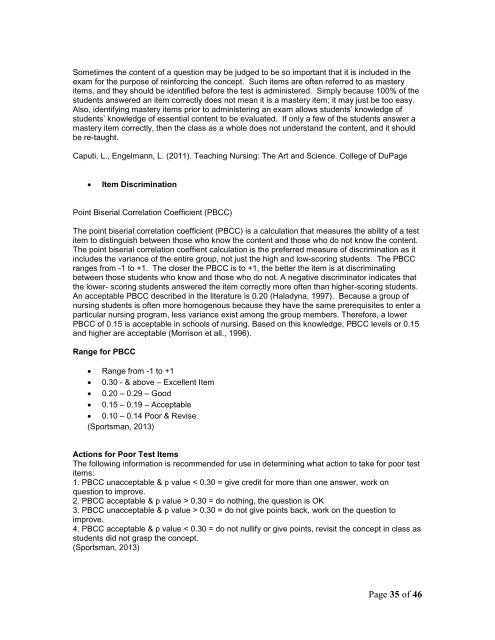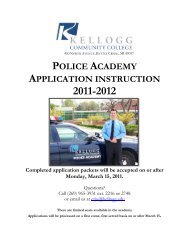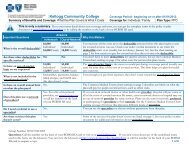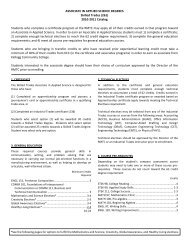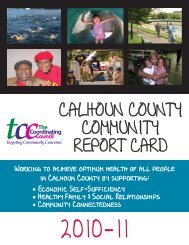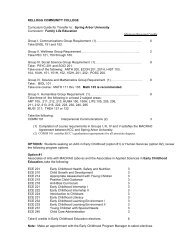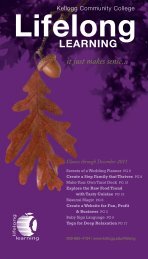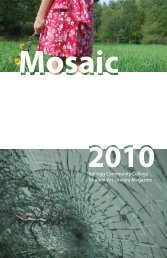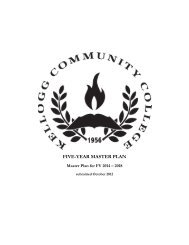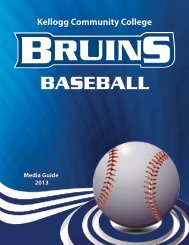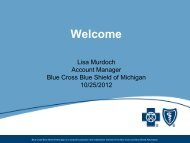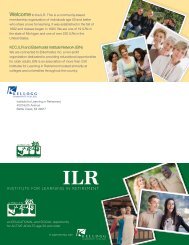Kellogg community college nursing student handbook
Kellogg community college nursing student handbook
Kellogg community college nursing student handbook
Create successful ePaper yourself
Turn your PDF publications into a flip-book with our unique Google optimized e-Paper software.
Sometimes the content of a question may be judged to be so important that it is included in the<br />
exam for the purpose of reinforcing the concept. Such items are often referred to as mastery<br />
items, and they should be identified before the test is administered. Simply because 100% of the<br />
<strong>student</strong>s answered an item correctly does not mean it is a mastery item; it may just be too easy.<br />
Also, identifying mastery items prior to administering an exam allows <strong>student</strong>s’ knowledge of<br />
<strong>student</strong>s’ knowledge of essential content to be evaluated. If only a few of the <strong>student</strong>s answer a<br />
mastery item correctly, then the class as a whole does not understand the content, and it should<br />
be re-taught.<br />
Caputi, L., Engelmann, L. (2011). Teaching Nursing: The Art and Science. College of DuPage<br />
<br />
Item Discrimination<br />
Point Biserial Correlation Coefficient (PBCC)<br />
The point biserial correlation coefficient (PBCC) is a calculation that measures the ability of a test<br />
item to distinguish between those who know the content and those who do not know the content.<br />
The point biserial correlation coeffient calculation is the preferred measure of discrimination as it<br />
includes the variance of the entire group, not just the high and low-scoring <strong>student</strong>s. The PBCC<br />
ranges from -1 to +1. The closer the PBCC is to +1, the better the item is at discriminating<br />
between those <strong>student</strong>s who know and those who do not. A negative discriminator indicates that<br />
the lower- scoring <strong>student</strong>s answered the item correctly more often than higher-scoring <strong>student</strong>s.<br />
An acceptable PBCC described in the literature is 0.20 (Haladyna, 1997). Because a group of<br />
<strong>nursing</strong> <strong>student</strong>s is often more homogenous because they have the same prerequisites to enter a<br />
particular <strong>nursing</strong> program, less variance exist among the group members. Therefore, a lower<br />
PBCC of 0.15 is acceptable in schools of <strong>nursing</strong>. Based on this knowledge, PBCC levels or 0.15<br />
and higher are acceptable (Morrison et all., 1996).<br />
Range for PBCC<br />
Range from -1 to +1<br />
0.30 - & above – Excellent Item<br />
0.20 – 0.29 – Good<br />
0.15 – 0.19 – Acceptable<br />
0.10 – 0.14 Poor & Revise<br />
(Sportsman, 2013)<br />
Actions for Poor Test Items<br />
The following information is recommended for use in determining what action to take for poor test<br />
items:<br />
1. PBCC unacceptable & p value < 0.30 = give credit for more than one answer, work on<br />
question to improve.<br />
2. PBCC acceptable & p value > 0.30 = do nothing, the question is OK<br />
3. PBCC unacceptable & p value > 0.30 = do not give points back, work on the question to<br />
improve.<br />
4. PBCC acceptable & p value < 0.30 = do not nullify or give points, revisit the concept in class as<br />
<strong>student</strong>s did not grasp the concept.<br />
(Sportsman, 2013)<br />
Page 35 of 46


